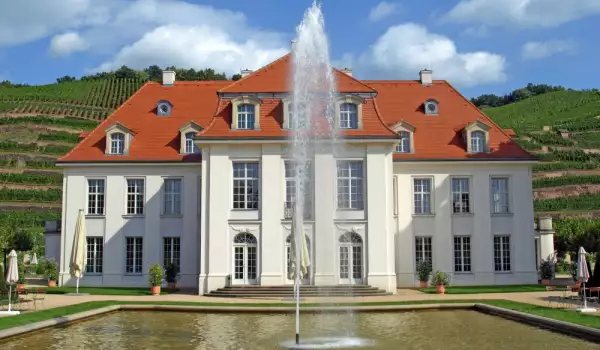Wackerbarth Palace

Wackerbarth Castle is one of several baroque palaces in Dresden, which was completely destroyed due to the bombing during World War II. Today the castle was turned into a place with full force which can be defined as an end of story.
Situated at the foot of the historic Radebeul vineyard, Wackerbarth Palace offers a tasteful atmosphere to its visitors and welcomes them into a unique palace, surrounded by beautiful baroque gardens.

Another essential feature for todays Wackerbarth Palace is that it represents a premium for sparkling wines. There you can have the pleasure to relax in the beautiful scenery of the Saxon part of the valley of the River Elbe with a glass of champagne in hand. According to someone in the Castle Wackerbarth you can even feel the taste of the Mediterranean.
The magnificent Castle Wackerbarth was built in the early 18th century as a private residence by the Earl of Wackerbarth - Count Augustus Christoph.
The foundations of the royal jewels were made in 1727, and finally the castle was completed in 1729. The original name of the estate was Wackerbarths Ruh. Project Author of the castle was architect - JC Knöffel. After building this palace it became known as the Knights Academy.
Soon after it was built, Wackerbarth Palace became synonymous with elegant wines, sparkling wines and enjoyment of life. Many lavish celebrations of the Saxon nobles were held in the beautiful gardens around the mansion and its lovely rooms. Even the Saxon King Augustus the Strong could not remain indifferent to the delicate atmosphere of the castle and aroma of the aged in barrels of wine.
Centuries later, today Wackerbarth Palace continues its 800-year tradition of wine making within the Saxon lands. The wine that is produced today in the castle is the same as that which is aged in the cellars from 200 years ago. Castle Wackerbarth has the title of the second oldest wine making establishment in Germany that uses only its own grown grapes.
During the Second World War the Wackerbarth Palace was seriously damaged. However, parts of its structure had survived the war and although its recovery had been absolutely possible, the forces of the communist regime destroyed it in 1963.
One part of the original preserved Castle Wackerbarth was a medallion with the image of the Saxon King Augustus the Strong on it. It was part of the ornamentation of the façade and is by the famous Baroque sculptor Benjamin Thomae.
It still remains unclear why other pearls of the palace architecture such as, the Japanese Palace and residence were also virtually destroyed by the bombing and are fully restored, yet, never the Wackerbarth Castle.















